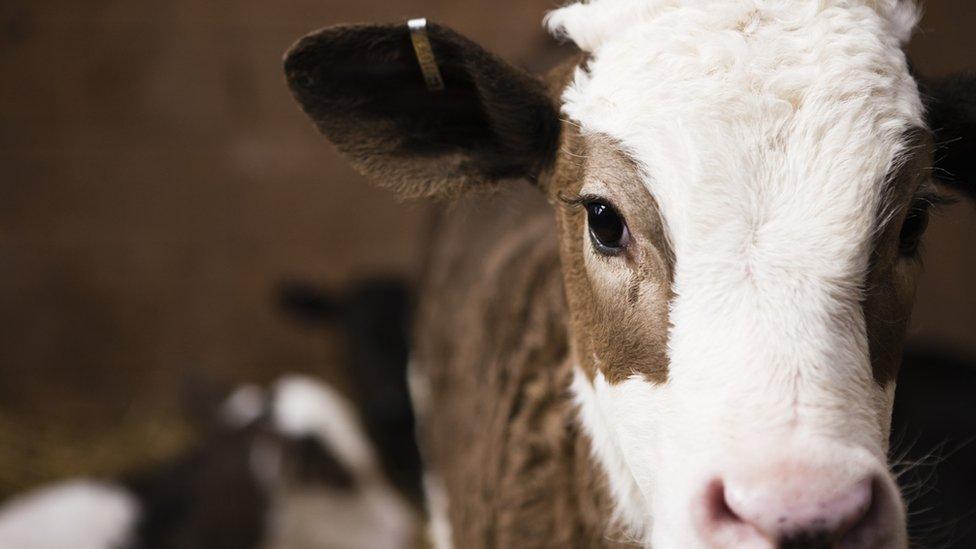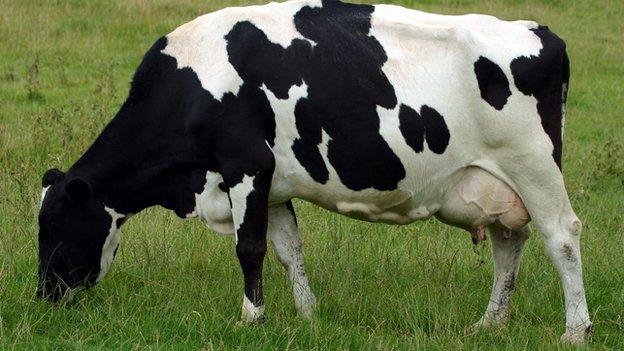'Mad cow disease' at Aberdeenshire farm after BSE confirmed
- Published

A case of BSE - so-called mad cow disease - has been confirmed at a farm in Aberdeenshire.
BBC Scotland understands the "isolated" case involves a beef herd in the Huntly area.
Rural Economy Secretary Fergus Ewing said a movement ban was now in place on the unnamed farm.
Investigations are under way to identify the origin of the disease - the first in Scotland in a decade - which was found after an animal died.
The case involving a five-year-old animal was identified before entering the human food chain.
Four others from the herd were being destroyed as a precaution.
There are understood to have been 16 cases in the UK since 2011, external, with the last in 2015 when farming officials confirmed a case of BSE in Carmarthenshire, Wales.
That was discovered following routine tests carried out when a farm animal dies.
The monitoring of BSE has been an important function since the crisis of 1986 when 180,000 cattle were infected and 4.4 million slaughtered in order to eradicate the disease in the UK.

Is there a risk to human health?
By Pallab Ghosh, science correspondent

Bovine spongiform encephalopathy (BSE) is a brain disorder in cattle that can be transmitted to humans who eat infected meat.
Mad cow disease - as it is more commonly known, because of the animals' erratic behaviour and movements - destroys their brains by eating away the nerve tissue.
The first recorded case in the UK was in 1986.
About 180,000 cattle were infected and 4.4 million slaughtered in order to eradicate the disease.
There was nationwide alarm following the confirmation of the first deaths caused by transmission of BSE to humans in 1996. At the time there were fears that hundreds of thousands of people might die as a result of eating infected beef.
As it turned out 178 people have died of the human form of mad cow disease, known as Variant Creutzfeldt-Jacob disease (CJD). It is believed that these individuals were genetically more sensitive to succumbing to the disease than the wider population.
Since then, cattle are closely monitored for signs of the disease and it seems that, in this instance, the surveillance system has worked well.
The cause is not known at this stage. But if it is an isolated case there is very little if any risk to human health.
According to Prof Matthew Baylis, Chair of Veterinary Epidemiology at the University of Liverpool, "BSE in cattle in the UK is largely over but there is still the odd detected case - one in 2014, two in 2015 and now one in 2018. It is too early to say if this case is significant".

On the Aberdeenshire case, Scotland's Chief Veterinary Officer Sheila Voas said: "I would urge any farmer who has concerns to seek veterinary advice."
She added: "While it is too early to tell where the disease came from in this case, its detection is proof that our surveillance system is doing its job.
"We are working closely with the Animal and Plant Health Agency to answer this question."
Andrew McCornick, president of NFU Scotland, said: "It is disappointing to learn of this BSE case within the Aberdeenshire area."
He added: "Whilst we lose our negligible risk status, it is not unexpected to see a new case and demonstrates the efficacy of the surveillance measures in place. This simply brings us back in line with the rest of Great Britain, reverting back to where we were 18 months ago.
"When Scotland applied for BSE negligible risk status it was with the full knowledge that there was every possibility of a sporadic case of BSE emerging as has been the case in France and Ireland."
Ian McWatt, director of operations in Food Standards Scotland, said that there were strict rules in place to protect consumers from the risk of BSE, including controls on animal feed.

What has changed since the BSE crisis?
By Kevin Keane, BBC Scotland environment and rural affairs correspondent
Although the BSE case in Scotland is significant, the industry is genuinely not concerned about any immediate impact. Movement restrictions only apply to the farm identified.
Unlike in the 1980s and 90s, the disease is more clearly understood. There have long been cases of BSE and there will continue to be so. But the practice of feeding infected meat and bonemeal back to the cattle was what led to the rapid acceleration in numbers which became the crisis.
Some of the most recent cases are a legacy of that - the offspring of older cattle. But the Aberdeenshire case is in a five-year-old animal and so it is likely that it was just predisposed to the condition.
A lot has changed since the BSE crisis. Brain and spinal cord no longer enter the food chain and there's a more rigorous process for monitoring. So the risk to human health is virtually nil. And it is not a condition that can be passed from animal to animal, other than through birth.
The biggest concern is in international confidence. BSE has long been a barrier to exporting beef as other countries did not want anything to do with nations where there had been cases.
It has been a decade since the last case in Scotland. A country is classed as 'negligible risk' 11 years after the birth of the last known case and that status was achieved in 2016. This latest case takes them back a step but only to the same level as the rest of the UK.
But with Brexit on the horizon - and wider trade deals being a big part of that - there are fears that this will be a barrier to entering new markets.
- Published23 June 2016

- Published6 October 2015

- Published11 September 2010